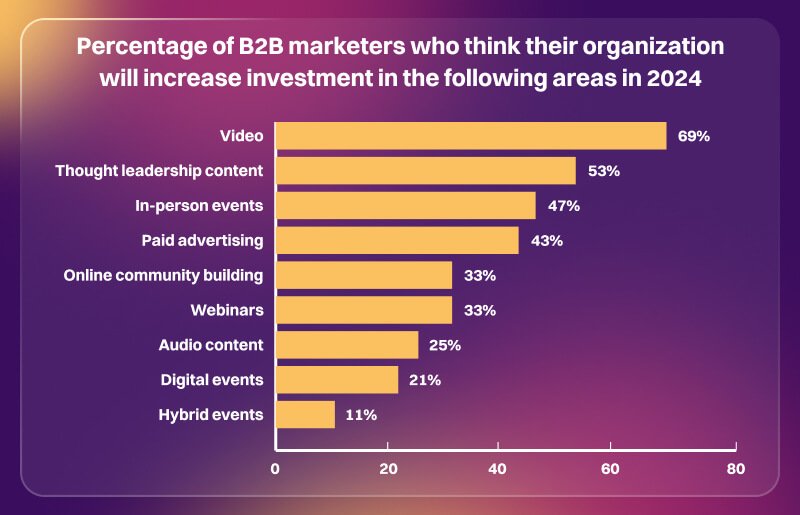
7 Outbound Marketing Tips to Future-proof Your Business
32% of marketers find outbound marketing effective in generating more leads. Brace yourselves, though, for 2024 is here – and it presents new opportunities for strategic refinement.
Ongoing shifts and uncertainties are inherent in today's business environment. Here, adaptability is key.
Amidst this backdrop of continual change, simply adhering to tried-and-tested outbound approaches may not be sufficient.
What worked wonders before might face challenges in this era of changing consumer preferences.
However, the past always comes with beneficial lessons. That being said, let’s explore seven tactics that have proven highly successful formerly.
But to help you navigate the dynamic marketplace effectively, we will explain how to tweak these strategies for optimal outcomes. So, let’s get started.
7 Successful Outbound Marketing Approaches to Apply in 2024
In the following sections, we'll dissect seven critical learnings from past successful outbound marketing. These insights will offer actionable strategies to navigate current challenges and fortify your business against future uncertainties. So, let’s start:
1. Content-Centric Campaigns
Successful outbound campaigns thrive on content that resonates. 73% of B2B marketers use content marketing as their overall marketing strategy.
Strategies involve a mix of the following:
- Content creation methodologies
- Diverse formats
- Effective distribution channels
- Alignment with overarching business objectives
Plus, when we say “distribution,” content syndication serves as an extremely potent approach. It amplifies the impact of your campaigns. How? By sharing your content through reliable 3rd-party platforms.
Strategies include distributing high-quality, insightful content across authoritative platforms – to build rapport and credibility.
Adapting Content-Centric Campaigns for the Future
In anticipation of a shifting landscape, consider redefining your content marketing approach. Here’s how:
- Use Lean Content: Transition to lean initiatives for impactful campaigns on a budget. Lean content refers to a strategic approach that minimizes resource utilization – while maximizing the impact of campaigns by emphasizing:
- Efficient
- Essential messaging
- Cost-effectiveness.
- Create User-Generated Content: Boost authenticity by using resources created by your users.
- Share Evergreen Content: Emphasize evergreen content to extend relevance and reduce the need for update frequency.
Example: As a financial institute, you can develop enduring resources on investment principles for consistent authority. - Tweak Content Syndication for Precision: Embrace niche platforms for targeted content syndication. Optimize your resources for voice search to enhance discoverability. Plus, leverage AI tools for data-driven syndication decisions.
- Prioritize Cost-Effective SEO: Explore budget-friendly SEO tactics to enhance organic visibility. Here are some examples:
- Use free or affordable tools to identify relevant keywords for your content.
- Improve title tags, meta descriptions, and headers to align with target keywords.
- Develop valuable and relevant content that engages your audience and attracts natural backlinks.
- Embrace Interactive Content: Integrate interactive elements (Q&A, polls, etc.) for maximum engagement – aligning with the 88% of marketers who find them compelling.
- Embed Videos: 69% of B2B marketers anticipate increased investment in video marketing in 2024.
Therefore, utilize this trend by integrating video into your storytelling process and refining the narrative for diverse formats. Once you establish the story, develop scripts to create videos with specific objectives, aligning seamlessly with the broader brand narrative. - Conduct Virtual Events: 47% of marketers focus on business gatherings to boost their brand’s reach.

Hence, consider the following areas for strategic allocation of your resources:
- Online Communities: Create and nurture digital spaces, like forums or social media groups. Here, your audience can interact, share experiences, and build a community around your brand or industry.
- Digital Events: Host online events, such as webinars or virtual conferences, as a budget-friendly alternative to physical gatherings.
- Hybrid Events: Combine in-person and virtual elements in hybrid events to accommodate local and distant attendees. It offers flexibility, extends reach, and addresses varying comfort levels or accessibility constraints, providing a more inclusive event experience.
2. Personalized Initiatives
Tailored outbound campaigns are efficient as they cater directly to individual preferences, increasing engagement and conversion rates.
99% of marketers say personalization helps advance customer relationships, with 78% claiming it has a“strong” or “powerful” impact.
Adapting Personalized Campaigns for the Future
Examine past campaigns and understand the role of data in creating messaging that resonates with individual audiences. You can then adapt these successful approaches to suit the contemporary market
Let’s see how:
- Tier Your Personalization: Implement tailored tactics to suit customer value segments for maximum resource optimization.
Note: "Customer value segments" refers to distinct buyer groups with similar characteristics, behaviors, and preferences determining their perceived value of a product or service. - Utilize Automated Tools: Streamline your processes by leveraging automated personalization tools to enhance efficiency and reduce manual workload.
For instance, you can automate product recommendations, increasing cross-selling opportunities.
- Leverage Client Feedback: Enhance your personalization strategies without additional costs by actively incorporating customer input into the process. Utilize surveys to refine personalized offerings, leading to an improvement in client satisfaction.
- Embrace Dynamic Personalization: Explore approaches based on real-time customer behaviors for cost-efficient adaptations.
3. Multichannel Outbound Strategies
Multichannel B2B campaigns are more efficient than single-channel efforts. Why? They leverage a combination of cold calls, social media, email, and traditional advertising, ensuring a broader reach and a cohesive narrative.
This approach recognizes and analyzes customer touchpoints across various channels, enhancing engagement and impact.
Adapting Multichannel Outbound Strategies for the Future
Here’s how you can modify this time-tested approach to suit any future economic slump:
- Prioritize High-Impact Channels: Focus on channels where your audience engages the most and is responsive – for cost-effective outreach.
Speaking about cost-effectiveness, it's been proven that holistic, cross-channel campaigns can improve budget efficiencies by 15 to 20% – by properly crediting marketing tactics with customer actions or influence. - Leverage Automation: Streamline resource allocation by embracing automated multichannel orchestration. You can use automation to perform cross-channel messaging during peak engagement hours. It reduces manual efforts and increases campaign productivity.
- Utilize Chatbots: Enhance customer interactions smoothly and cost-effectively by integrating messaging apps. You can use chatbots for customer queries, reducing response times and cutting customer service costs.
- Explore Influencer Collaborations: Despite budget constraints, seek partnerships with industry influencers for amplified reach. Studies show that influencer collaborations can yield a return on investment of up to $6.50 for every dollar spent.
- Implement Geotargeting Strategically: Maximize local impact with limited expenses by strategically executing geotargeting and geofencing. With customized geotargeting, you can achieve the following:
-
- 30% increase in leads
-
- 20% higher conversions
-
- 10% rise in customer satisfaction
4. Data-Driven Decision-Making
A significant chunk of B2B marketers unanimously affirm the paramount importance of data in steering their decision-making tactics.
Data is particularly advantageous for crafting personalization and targeting strategies.
That’s why about 82% of senior marketers intend to boost data utilization in the coming year.
Adapting Data-Driven Decision-Making for the Future
Let’s now explore how you can make informed decisions while managing costs effectively with the help of data.
- Maximize Value: Optimize the value of available data for informed decision-making while minimizing costs. For instance, you can utilize your CRM data to identify high-value leads, reduce acquisition costs, etc.
- Implement Predictive Analytics: Proactively make decisions with limited resources via predictive analytics for forecasting and strategy planning.
Example: Let’s say you head the marketing team of a manufacturing company. You can employ predictive analytics to anticipate market trends, resulting in reduced inventory costs.
- Leverage Customer Journey Mapping: Enhance data-driven strategies without significant investments by mapping customer interactions across critical touchpoints. It helps improve the overall buyer experience and reduce churn rates.
- Explore Alternative Tech: Gain budget-friendly insights by exploring alternate technologies such as open-source data analytics tools. For instance, tools like Apache Hadoop or Apache Spark are freely available, reducing software licensing costs.
They also often run on commodity hardware. It lowers infrastructure expenses and makes them cost-effective data analysis alternatives compared to some proprietary solutions.
- Implement DIY Data Cleansing: Use do-it-yourself data cleansing and enrichment techniques for lean operations. It can help maintain data accuracy and save costs on external services.
5. Cold Emailing
The success of your cold email campaigns hinges on strategies for crafting compelling and personalized campaigns that resonate with recipients.
It also involves the meticulous analysis of cold email A/B testing and optimization techniques – to enhance the effectiveness of your outreach efforts.
Adapting Cold Emailing for the Future
Here’s how you can streamline your email workflows to reduce operational costs and maximize outcomes:
- Implement Segmentation: Optimize email content relevance by applying targeted segmentation based on customer behaviors and preferences.
- Explore Alternative Platforms: Check out other cost-effective platforms for email outreach. Consider how the platforms align with your budget constraints.
For instance, let’s say you use Mailchimp. You can consider replacing it with Brevo or MailerLite here. These platforms offer similar features to Mailchimp but have lower costs for certain usage levels, making them cost-effective alternatives.
- Utilize Analytics: Use analytics to refine email strategies based on performance metrics, ensuring ongoing optimization.
6. Direct Mail Outreach
The response rate for direct mail is 5.3% for prospect lists – one of the highest response rates across all marketing mediums.
So, how can you leverage this approach to achieve the maximum benefits in the future? Here’s how:
Adapting Direct Outreach
By adapting several clever approaches, you can optimize direct mail effectiveness in the digital age. Here are our select few:
- Digitize Your Approach: Embrace digitization in your campaigns. Embed QR codes in direct mail pieces, linking recipients to interactive online content and increasing response rates.
- Optimize Budgets: Reduce direct mail budgets by focusing on high-value target segments.
- Explore Eco-Friendly Options: Check out eco-friendly and cost-effective inventory for direct mail campaigns, considering sustainability and budget constraints.
For example, you can use recycled materials in your mail to align with your client’s sustainability goals and reduce campaign costs. - Utilize Data: Enhance targeting precision by integrating data analytics to identify the most responsive demographics for direct mail.
7. Tradeshows and Conferences
These events help you showcase products and network. You can maximize tradeshow effectiveness through impactful booth design and engaging presentations.
Adapting Tradeshows and Conferences for the Future
- Host Virtual Events: Hold online tradeshows as a budget-friendly alternative to physical events. It reduces costs associated with travel and booth logistics while maintaining engagement levels.
- Collaborate with Industry Associations: Join hands with related business organizations and associations in your industry for joint virtual events. It helps you cut down on costs and expand your reach.
Conclusion: Future-Proofing Outbound Marketing
As we navigate the dynamic landscape of outbound marketing in 2024, the lessons learned from successful strategies provide you with a roadmap for resilience. However, always remember that agility, innovation, and prompt response to challenges are the keys to success.
You should team up with Revnew to revolutionize your outbound marketing approaches to stay ahead. Revitalize your strategy now.




